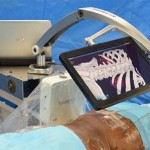Article of the Week: Minimum five-year follow-up of 1,138 consecutive laparoscopic radical prostatectomies
Every week the Editor-in-Chief selects the Article of the Week from the current issue of BJUI. The abstract is reproduced below and you can click on the button to read the full article, which is freely available to all readers for at least 30 days from the time of this post.
In addition to the article itself, there is an accompanying editorial written by a prominent member of the urological community. This blog is intended to provoke comment and discussion and we invite you to use the comment tools at the bottom of each post to join the conversation.
Finally, the third post under the Article of the Week heading on the homepage will consist of additional material or media. This week we feature a video from Ricardo Soares, discussing his paper.
If you only have time to read one article this week, it should be this one.
Minimum five-year follow-up of 1,138 consecutive laparoscopic radical prostatectomies
OBJECTIVES
To investigate the long-term outcomes of laparoscopic radical prostatectomy (LRP).
PATIENTS AND METHODS
In all, 1138 patients underwent LRP during a 163-month period from 2000 to 2008, of which 51.5%, 30.3% and 18.2% were categorised into D’Amico risk groups of low-, intermediate- and high-risk, respectively. All intermediate- and high-risk patients were staged by preoperative magnetic resonance imaging or computed tomography and isotope bone scanning, and had a pelvic lymph node dissection (PLND), which was extended after April 2008. The median (range) patient age was 62 (40–78) years; body mass index was 26 (19–44) kg/m2; prostate-specific antigen level was 7.0 (1–50) ng/mL and Gleason score was 6 (6–10). Neurovascular bundle was preservation carried out in 55.3% (bilateral 45.5%; unilateral 9.8%) of patients.
RESULTS
The median (range) gland weight was 52 (14–214) g. The median (range) operating time was 177 (78–600) min and PLND was performed in 299 patients (26.3%), of which 54 (18.0%) were extended. The median (range) blood loss was 200 (10–1300) mL, postoperative hospital stay was 3 (2–14) nights and catheterisation time was 14 (1–35) days. The complication rate was 5.2%. The median (range) LN count was 12 (4–26), LN positivity was 0.8% and the median (range) LN involvement was 2 (1–2). There was margin positivity in 13.9% of patients and up-grading in 29.3% and down-grading in 5.3%. While 11.4% of patients had up-staging from T1/2 to T3 and 37.1% had down-staging from T3 to T2. One case (0.09%) was converted to open surgery and six patients were transfused (0.5%). At a mean (range) follow-up of 88.6 (60–120) months, 85.4% of patients were free of biochemical recurrence, 93.8% were continent and 76.6% of previously potent non-diabetic men aged <70 years were potent after bilateral nerve preservation.
CONCLUSIONS
The long-term results obtainable from LRP match or exceed those previously published in large contemporary open and robot-assisted surgical series.




We are indebted to the excellent surgeon C.G.E. and his colleagues for this data. It is commendable that the data has been produced.
The data does not contain comprehensive natural numbers concerning the patients reported, and their categorization: some data is reported by number and some by percentages. So, in order to make my comment, I need to provide definitions and make some (I hope, reasonable) assumptions.
Since the object of LRP is to cut out the cancer without re-occurrence, I am going to define an operation as “unsuccessful” if, despite the inconvenience of the operation, there is a biochemical reoccurrence as defined by the authors.
I also need to make an assumption about the percentages applicable to different cohorts of the patients. With one exception, I am going to assume that those percentages they are evenly distributed across the 1138 patients reported. The exception is for those patients who were potent and non-diabetic prior to the LRP, since the natural number of them, and the incidence of other factors applicable to them, is not reported as such by the authors. It is their case – not that of the general body of men – that I am going to examine in this comment.
I am also going to round the figures that I produce below up or down to make for ease of reading.
On the basis of the foregoing assumptions, what this excellent article appears to show is that, for every 100 potent non-diabetic men who undergo LRP, sadly on roughly 15 cases the CaP is not eliminated (biological recurrence). For those 15 cases, sadly, the inconvenience of the operation has not resulted in certainty of cure.
But, of course, this does leave 85 such men without recurrence of CaP by the definition adopted. This is very good, but the next question is what has the LRP operation cost this cohort of men?
The first thing is that, of the 85 men “cured”, approximately 24% (say, approximately 20 men) are no longer potent (defined by the authors as, even after 5 years, not able to achieve vaginal penetration that they could before, even with viagra). That is quite a significant cost for those men. In addition, some of the 20 men are now also incontinent, but I pass that over, because loss of potency is bad enough.
This leaves 65 men who remain potent, or achieve potency, within the 5 years.
However, next we have to notice that, of those 65 men, approximately 6% (say approximately, 4 men) have been left incontinent after the operation (defined as still needling pads etc).
So, if that is right, this brings us down to 61 men. However, as the authors make clear, some 29 men in the entire cohort of 1138 (5.9%) have had Grade IIIb complications as a result of the operation, one of which was a pulmonary embolism case of a patient who, it appears, sadly died.
I don’t think it is a real worry if some men have Grade IIIb complications that are quickly resolved, but, of course, for some men, the complication will be a more permanent issue, and so I am going to allow for this, I hope fairly, by allowing that 1 man of the 61 men cohort of potent non diabetic men remaining to be so affected.
If you have followed me so far, you will see that, what this excellent study appears to evidence is that, for 100 potent non-diabetic men who have LRP, 60 are “cured” and have no long term impotency, incontinence or complication. But that 40 such persons are either not cured, or are impotent or incontinent or suffer some complication after the inconvenience of the operation. Roughly a 60%-40% split.
The authors’ conclusion is that the skill of the surgeon is very important. Accordingly, we have to remember that not every surgeon will be as skilled, or as experienced, as C.G.E. Other surgeons may have worse results. If it were the case (and I do not know that it is) that a 60%-40% split was among the best outcomes, what might be the percentages for those not so skilled?
While, therefore, one would want to applaud a 60% rate for no (defined) CaP recurrence and no (defined) collateral “damage” to the patient, I have to say that, if I were a patient, I personally would regard LRP as quite a risky operation, if it has a 40% non-success/serious long-term problem rate.
Another point is that the excellent authors of this paper only put forward 5 year survivorship data, and not mortality statistics, through entirely no fault of their own but just due to the facts of life – naturally they do not have long term data (yet). Since, however, one would expect many men in the study (median age 62 years) to survive for 5 years, what one really wants to know is whether, for the inconvenience of the operation, there actually turns out to be a significant improvement to the mortality of the men who underwent the operation (especially but not limited to the 60 “successes” and, if so, what that difference was). It is not a criticism of the authors that such data is not yet available. However, what this does show that the study does not address a significant question: doctor, if I have the operation, will I live any longer?
I am not a doctor. I have the misfortune to be a lawyer. And, therefore, I would like to finish by pointing out that three weeks ago, in a case called Montgomery v Lanarkshire Health Board , the UK Supreme Court has re-defined and restated the duties of doctors in practice in Britain. The Court’s ruling is on the Supreme Court’s website and every doctor in the UK should become familiar with it now, because the Court’s ruling is binding on all doctors already and had been for three weeks.
In short, and in not very different terms from the GMC, the Court has laid down that the old Sidaway/Bolam test (broadly, that a competent body of doctors knows best what to advise the patient) is a bit outdated and is no longer to be applied, and that doctors must advise patients of “any” material risks of an operation and alternatives.
It seems to me therefore that urological surgeons in the UK need to address in some detail the risks that their patients face when the patients have LRP. I am sure they have been doing that already, but it seems to me that it is not good enough to say “you might end up incontinent” or “you might end up impotent” or “you might have a pulmonary embolism” but that some sort of fair advice as to the size of that risk is appropriate.